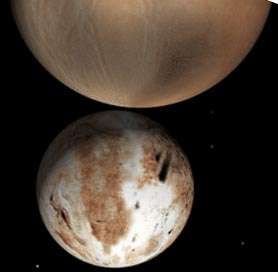Capturing planets

(Phys.org) -- The discovery of planets around other stars has led to the realization that alien solar systems often have bizarre features - at least they seem bizarre to us because they were so unexpected. For example, many systems have giant planets closer to their star than Mercury is to the Sun, while other have the opposite - giant planets more than ten times farther way from their star than Jupiter is from our Sun. Astronomers think they understand how planets could end up close to the star: they gradually drift in from more customary orbits. But how can planets end up so far away?
A new theoretical study by CfA astronomer Hagai Perets and his colleague proposes a possible answer: the distant planets are not part of the original stellar system - they were captured by the star. Astronomers know that there are many so-called "free floating planets" in space - planets that have been tossed out of their original solar system by a random gravitational encounter with another planet. Some of these orphan planets have recently been detected.
The scientists calculated that it would be possible for a star to capture one of these orphans if the conditions were right; namely, if the star and planet happen to pass close to each other with only a small velocity difference, and if there are no other massive bodies nearby to interfere with the "adoption." They ran a series of computer simulations to test all these and other possibilities, and they found not only that such a capture was possible, but that a star could even capture several orphan planets.
In fact, they found that sometimes two free floating planets could capture one another and form a binary planet. None of these binaries has yet been seen, although some astronomers think that since Pluto and its moon Charon have such similar masses they are a binary system, although not necessarily one that was captured.
The new results seem to offer a reasonable, if exotic, explanation for some of the complex planetary configurations that have been discovered, and they remind us that nature is full of surprises.
Provided by Harvard-Smithsonian Center for Astrophysics





















